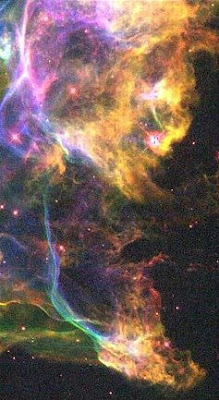
NGC 1569 is a hive of star birth activity, emitting huge bubbles and super-bubbles that permeate the main mass of NGC 1569. These events are involved in the creation of new stars and superluminous blue star clusters. Approximately 25 million years ago, NGC 1569 galaxy had a sudden onset of star birth , subsiding about the time of Earths early Human Ancestors.
In this new image, taken with the NASA/ESA Hubble Space Telescope, the bubble structure is formed by the galactic super-winds and outflows. Thes are caused by an immense input of power from collective supernova explosions.
The structures that look like bubbles in this image are made of hydrogen gas that glows when coming into contact with the galactic winds and radiation from other hot young stars and is tormented with supernovae shocks. The first supernovae blew up as the most massive stars reached the end of their lifetimes. This occured about 20-25 million years ago.

The environment in NGC 1569 very turbulent and the supernovae which produce the gaseous raw material nnecessary for the formation of further stars and star clusters, triggering their birth in swirls of gas.
Credits: ESA, NASA and Peter Anders (Göttingen University Galaxy Evolution Group, Germany)
NGC 1569 is a peculiar dwarf galaxy, which experienced a very high rate of star formation in the past 150 million years. At the moment, the star formation rate seems to decline a bit. At a distance of only 2.2 Megaparsec, it is the nearest starburst galaxy (you might have though M 82 was the nearest!). The outflow of gas from NGC 1569 has been studied in great detail. In my thesis (Chapter 8), I present maps of the high-velocity NEUTRAL hydrogen in NGC 1569, as well as a previously unknown nearby cloud of atomic hydrogen which might be colliding with NGC 1569.
NGC 1569 is a peculiar dwarf galaxy, which experienced a very high rate of star formation in the past 150 million years. At the moment, the star formation rate seems to decline a bit. At a distance of only 2.2 Megaparsec, it is the nearest starburst galaxy (you might have though M 82 was the nearest!). The outflow of gas from NGC 1569 has been studied in great detail. In my thesis (Chapter 8), I present maps of the high-velocity NEUTRAL hydrogen in NGC 1569, as well as a previously unknown nearby cloud of atomic hydrogen which might be colliding with NGC 1569.















